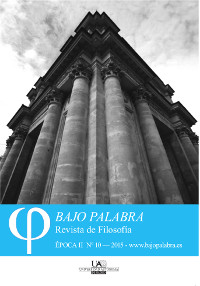Science and Imagination In the Aesthetic Appreciation of Nature: An Approach to the Work of Tim Birkhead and John Baker
Keywords:
Aesthetics of nature, Scientific Cognitivism, Aesthetic Imagination, Tim Birkhead, John BakerCopyright (c) 2015 Fernando Arribas Herguedas

This work is licensed under a Creative Commons Attribution 4.0 International License.
Abstract
This article sketches a moderately pluralist perspective of the aesthetic appreciation of nature, harmonizing the central thesis of Allen Carlson’s cognitive-scientific model with other approaches that award the imagination a crucial role, such as those of Ronald Hepburn and Emily Brady. To do this, we appeal to a parallel reading of two works that are not strictly philosophical: Bird Sense, by the biologist Tim Birkhead, and The Peregrine by John A. Baker. Both works intend to contemplate the world from a different consciousness that demands the simultaneous concurrence of the scientific method and the imaginative effort particular to philosophical discourse and the aesthetic sensibility.
Downloads
References
Baker, John (2011), The Peregrine, The Hill of Summer and Diaries: The Complete Works of J. A. Baker, Londres, Collins.
Berleant, Arnold (1992), The Aesthetics of Environment, Philadelphia, Temple University Press.
Birkhead, Tim (2012), Bird Sense. What It’s Like to Be a Bird, Londres, Bloomsbury.
Brady, Emily (1998), “Imagination and the Aesthetic Appreciation of Nature”, The Journal of Aesthetics and Art Criticism 56, 2, pp. 139-147.
Brady, Emily (2003), Aesthetics of the Natural Environment, Tuscaloosa, University of Alabama Press.
Carlson, Allen (2000), Aesthetics and the Environment: The Appreciation of Nature, Art and Architecture, Nueva York / Londres, Routledge.
Foster, Cheryl (1998), “The Narrative and the Ambient in Environmental Aesthetics”, Journal of Aesthetics and Art Criticism 56, 2, pp. 127–137.
Fudge, Robert (2001), “Imagination and the Science-Based Aesthetic Appreciation of Unscenic Nature”, The Journal of Aesthetics and Art Criticism 59, 3, pp. 275-285.
Gray, John (2013), El silencio de los animales. Sobre el progreso y otros mitos modernos, Madrid, Sexto Piso.
Hepburn, Ronald (1996), “Landscape and the Metaphysical Imagination”, Environmental Values 5, pp. 191-204.
Hepburn, Ronald (2001), “Trivial and Serious in Aesthetic Appreciation of Nature”, en Ronald Hepburn, The Reach of the Aesthetic: Collected Essays on Art and Nature, Aldershot, Ashgate, pp. 1-15.
Nagel, Thomas (1974), “What Is It Like to Be a Bat?”, The Philosophical Review, 83, 4, pp. 435-450
Oelschlaeger, Max (1991), The Idea of Wilderness. From Prehistory to the Age of Ecology, New Haven, Yale University Press.
Parsons, Glenn (2008), Aesthetics and Nature, Londres, Continuum.
Saito, Yuriko (1998), “The Aesthetics of Unscenic Nature”, Journal of Aesthetics and Art Criticism, 56, 2, pp. 101-111.
